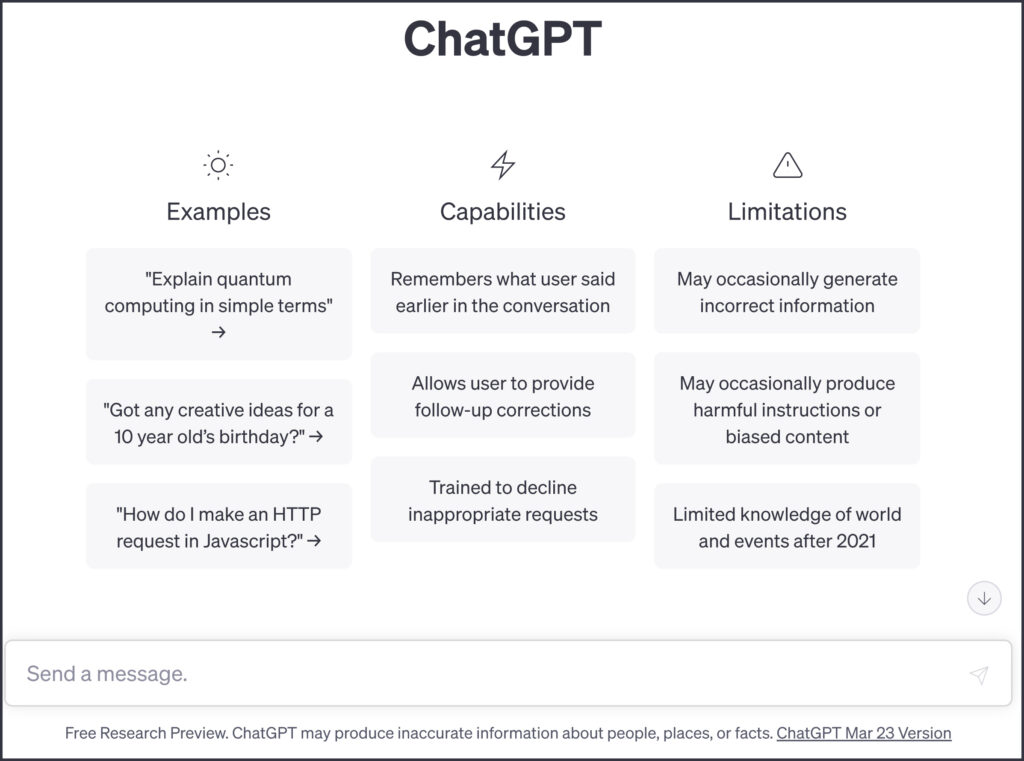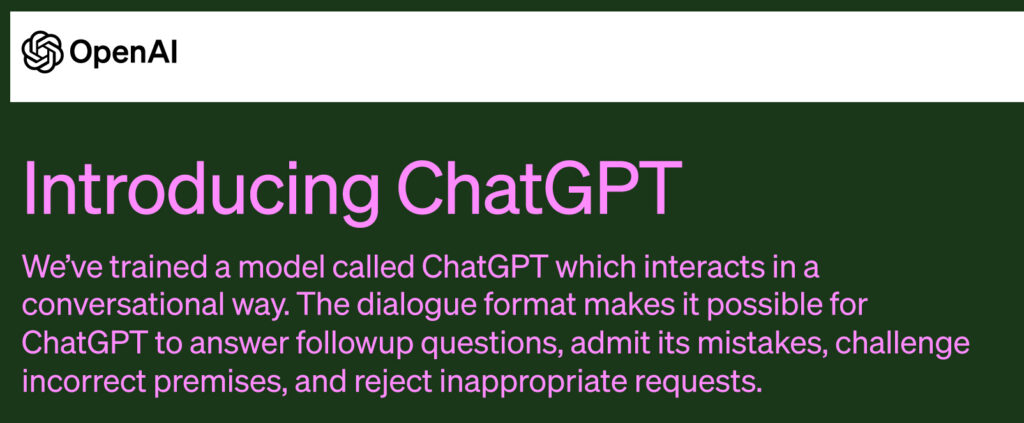As a large language model trained on vast amounts of data, ChatGPT is capable of generating human-like text and answering a wide range of questions. If you’re new to using ChatGPT, here’s a step-by-step guide to help you get started. How to Use ChatGPT? ChatGPT is a Powerful Conversational AI. How to Use ChatGPT Powerful Conversational AI
How to Use ChatGPT STEP -1
Step 1: Choose a platform ChatGPT can be accessed through a variety of platforms, including websites, chatbots, and mobile apps. Some popular platforms include OpenAI’s API, Hugging Face’s transformers library, and GPT-3 based chatbots like Replika and AI Dungeon.
How to Use ChatGPT STEP -2
Step 2: Choose a language ChatGPT can generate text in several languages, including English, Spanish, French, German, Italian, and Chinese. Be sure to select the language you want to use before interacting with Conversational AI.
How to Use ChatGPT STEP -3
Step 3: Choose a prompt A prompt is a starting sentence or phrase that ChatGPT uses to generate its response. Choose a prompt that is specific and clear to get the best results. For example, if you want to know the meaning of a word, you could use the prompt “What does [word] mean?”.
How to Use ChatGPT STEP -4
Step 4: Send your prompt to ChatGPT Once you’ve chosen a prompt, type it into the chatbox or input field provided by the platform you’ve chosen. ChatGPT will analyze your prompt and generate a response based on the language and the data it has been trained on.
How to Use ChatGPT STEP -5
Step 5: Review and edit the response ChatGPT’s response will appear in the chatbox or input field after a short delay. Review the response to see if it meets your needs. If the response is not what you were looking for, you can edit your prompt and try again.
How to Use ChatGPT STEP -6
Step 6: Continue the conversation If you’re satisfied with ChatGPT’s response, you can continue the conversation by asking follow-up questions or providing additional prompts. Remember to be clear and specific in your prompts to help ChatGPT generate the most accurate and useful responses.
How to Use ChatGPT STEP -7
Step 7: Evaluate the response As with any AI system, ChatGPT’s responses may not always be perfect. Take the time to evaluate the response and consider its accuracy and usefulness. If you’re using Conversational AI for a specific task or application, you may want to compare its responses to those of other sources or consult with a human expert.
In conclusion, using ChatGPT can be a powerful tool for generating text and answering questions. By following these steps, you can start using ChatGPT today and tap into its vast knowledge and language capabilities.
As an artificial intelligence language model, Conversational AI is a powerful tool for answering questions and generating responses in a conversational format. With its ability to process natural language and generate human-like responses, ChatGPT has become increasingly popular for a variety of applications, from customer service to educational and entertainment purposes.

If you’re interested in using ChatGPT, here’s a step-by-step guide on how to get started:
How to Use ChatGPT Powerful Conversational AI
Step 1: Choose a platform to access ChatGPT
There are various platforms available that allow users to access ChatGPT. Some of the most popular include:
- Hugging Face: A platform that provides access to various pre-trained language models, including ChatGPT.
- OpenAI API: An API service offered by OpenAI that allows developers to access the latest language models.
- DialoGPT: A specific implementation of the GPT architecture designed specifically for dialogue generation.
Step 2: Accessing the ChatGPT model
Once you’ve chosen a platform, you’ll need to access the ChatGPT model. This typically involves loading the model into your application or program using an API key or other authentication method. Depending on the platform you’ve chosen, the process may vary slightly.
Step 3: Inputting text
To generate a response from ChatGPT, you’ll need to input text into the model. This can be done via a text input box or through a chat interface. The model will then process the input text and generate a response.
Step 4: Reviewing the output
Once the model has generated a response, you’ll need to review the output to ensure that it meets your needs. Depending on the application, you may need to further process the output before presenting it to a user.
Step 5: Iterating and refining
As with any machine learning model, using ChatGPT often involves an iterative process of testing and refining. This may involve adjusting the input parameters, modifying the training data, or fine-tuning the model to better meet your needs.
ChatGPT is a powerful tool that can be used for a variety of applications. By following the steps outlined above, you can begin to explore the capabilities of this exciting language model and discover how it can be used to enhance your own projects and applications.

Here are some additional tips for using ChatGPT:
- Understand the limitations of the model: While ChatGPT is a powerful tool, it’s important to understand its limitations. For example, the model may struggle with generating responses to complex or nuanced questions, or it may produce responses that are biased or insensitive. Always review the output carefully and be prepared to make adjustments as needed.
- Train the model with appropriate data: Depending on the application, you may need to train the ChatGPT model with specific data that is relevant to your domain. This can help to improve the accuracy of the model and ensure that it produces responses that are tailored to your needs.
- Consider integrating with other tools and technologies: ChatGPT can be integrated with a variety of other tools and technologies, such as chatbots, voice assistants, and natural language processing (NLP) frameworks. By combining these tools, you can create more sophisticated applications that can handle a wider range of user interactions.
- Engage in ongoing monitoring and evaluation: As with any machine learning model, it’s important to engage in ongoing monitoring and evaluation to ensure that the ChatGPT model is performing as expected. This can involve monitoring metrics such as accuracy, response time, and user satisfaction, and making adjustments as needed.
Overall, using ChatGPT can be a rewarding and exciting experience, allowing you to explore the capabilities of artificial intelligence and create more engaging and interactive applications. By following these tips and staying up-to-date on the latest developments in the field, you can continue to enhance your skills and develop even more powerful applications.
Here are a few more tips for using ChatGPT:
- Fine-tune the model for your specific use case: Depending on your specific use case, it may be necessary to fine-tune the ChatGPT model using your own data. This can help to improve the accuracy and relevance of the responses generated by the model, and ensure that it is tailored to your specific needs.
- Use conversational best practices: When using ChatGPT to generate responses in a conversational format, it’s important to follow best practices for conversational design. This includes using natural language, avoiding jargon, and ensuring that responses are concise and relevant.
- Consider user privacy and security: When using ChatGPT for applications that involve sensitive information or personal data, it’s important to consider user privacy and security. This may involve encrypting data, anonymizing user information, and following best practices for secure data handling.
- Experiment with different input formats: While ChatGPT is often used with text inputs, it can also be used with other input formats such as voice, images, or video. Experimenting with different input formats can help you create more engaging and interactive applications that are better suited to your users’ needs.
By following these tips and experimenting with different approaches, you can unlock the full potential of ChatGPT and create innovative and engaging applications that meet the needs of your users.
Here are a few additional tips for using ChatGPT:
- Use pre-processing techniques to improve input quality: In order to generate high-quality responses, it’s important to ensure that the input data is of good quality. Pre-processing techniques such as spell-checking, grammar correction, and sentence normalization can help to improve the quality of the input and reduce the chances of the model generating inaccurate or irrelevant responses.
- Understand the context and intent of the conversation: To generate accurate and relevant responses, ChatGPT needs to understand the context and intent of the conversation. This may involve analyzing previous messages in the conversation, as well as using techniques such as named entity recognition (NER) and sentiment analysis to better understand the user’s needs.
- Consider ethical implications: As with any technology, it’s important to consider the ethical implications of using ChatGPT. This may involve considering issues such as bias, transparency, and accountability, as well as developing policies and guidelines for responsible use.
- Continuously monitor and update the model: ChatGPT is a dynamic model that can benefit from continuous monitoring and updating. This may involve retraining the model with new data, adjusting the model parameters, or adding new features to improve its performance over time.
By following these tips and staying up-to-date on the latest developments in the field, you can ensure that you are using ChatGPT to its fullest potential and creating applications that meet the needs of your users while also adhering to ethical and responsible practices.




One thought on “How to Use ChatGPT Powerful Conversational AI”